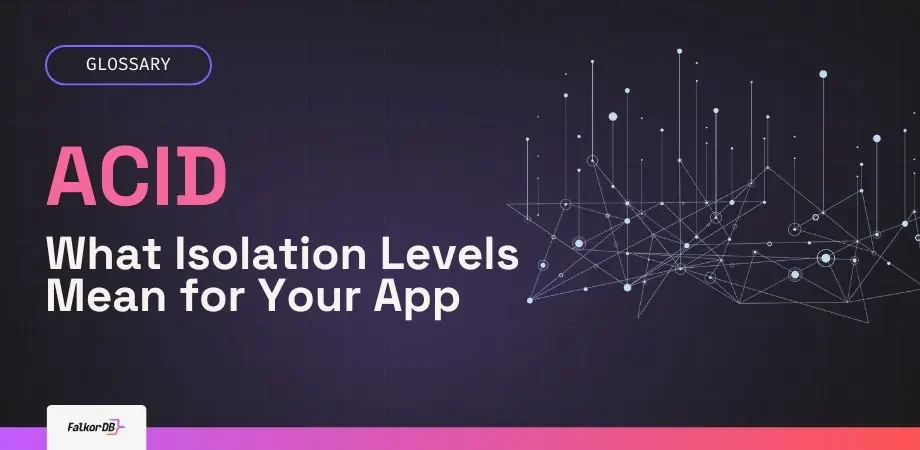Highlights
- Understand ACID properties: Atomicity, Consistency, Isolation, Durability, and their impact on data integrity.
- Choosing the right ACID isolation level prevents concurrency issues.
- Snapshot Isolation provides consistency and reduces custom concurrency control overhead.
ACID Transactions: What Isolation Levels Mean for Your App
Database ACID transactions are fundamental, ensuring data integrity using appropriate isolation levels in multi-user setups. Data consistency ensures data stays correct and valid across transactions. To maintain consistent data, databases use the principles of ACID transactions. ACID stands for Atomicity, Consistency, Isolation, and Durability.
- Atomicity means a transaction is a single, indivisible unit: all changes commit, or none do.
- Consistency ensures the database maintains a valid state before and after the transaction, following constraints.
- Isolation gives concurrent transactions independence, executing each in isolation, important for multi-user databases.
- Durability guarantees that once a transaction commits, changes are permanent.
Let’s focus on the isolation property, defining database isolation levels. Isolation levels are vital because they dictate consistency in multi-user systems.
They manage the interaction between transactions, ensuring correct results. The goal is to leverage server cores with parallel computing; databases should handle transactions concurrently.
Managing a higher isolation level enhances data consistency but can increase memory use and reduce concurrency. The right isolation level depends on consistency needs, performance, and transaction types.
Popular isolation levels include:
- Read Uncommitted
- Read Committed
- Cursor Stability
- Oracle Read Consistency
- Snapshot Isolation
- Serializable
Each isolation level impacts performance due to locking; isolation levels depend on vendor implementation and can be weaker or stronger than defined. Consider potential issues from lower isolation levels.
Concurrency Control
Traditional concurrency control puts too much responsibility on developers. A new approach shifts this to the database system. Modern databases involve complex transactions, forcing developers to write complex logic, increasing errors.
The solution involves the database actively managing concurrency, analyzing transaction patterns to generate customized control mechanisms. Using Snapshot Isolation as a default provides developers guarantees and reduces custom concurrency control. It ensures each transaction sees a consistent database snapshot at the start, regardless of concurrent changes.
Consider these tradeoffs with isolation levels:
- Execution time (latency vs. throughput)
- Scalability
- Memory usage
- Development and SRE time spent fixing bugs from weak isolation
Carefully evaluate needs when selecting an isolation level; a sensible default simplifies development and ensures a solid base.
ACID vs BASE: Data Consistency Explained
When working with NoSQL databases, data consistency models can differ from relational databases. The two common models are ACID and BASE. Both have advantages, and neither is always a perfect fit. Let’s examine the tradeoffs.
ACID Model
ACID has been the norm, providing a safe environment for data operations. The acronym stands for:
- Atomic: Transactions either fully succeed or fully roll back.
- Consistent: The database remains in a consistent state after transactions.
- Isolated: Transactions don’t interfere with each other.
- Durable: Transaction results are permanent, even with failures.
Industries like finance and healthcare widely use ACID-compliant databases, as do many small-to-medium enterprises for their ease of use. Write consistency means data is consistent and stable once a transaction completes, but requires sophisticated locking. Most graph databases use ACID for consistently stored data.
BASE Model
ACID transactions can be too pessimistic for some domains. In NoSQL databases relying on sharding and horizontal scale-out, ACID compliance is costly. Thus, these databases use the BASE transaction model. BASE stands for:
- Basic Availability: The database works most of the time.
- Soft-state: Stores don’t have to be write-consistent, nor do different replicas have to be mutually consistent all the time.
- Eventual consistency: Stores will exhibit consistency at some later point.
Large companies in unregulated spaces processing terabytes of data use BASE. These companies reach a point where ACID overhead hurts operations. BASE values availability but doesn’t guarantee consistency of replicated data at write time. BASE offers a less strict assurance: data will be consistent in the future.
The Trade-offs
ACID or BASE? It’s not one-size-fits-all. ACID shines where reliability is non-negotiable—think banking or healthcare. BASE thrives in high-scale, low-stakes setups where availability trumps instant consistency. If ACID’s your pick, a graph database like FalkorDB can model relationships with blazing speed. With BASE, you’ll need discipline to handle its lax consistency. Evaluate your app’s priorities—there’s no wrong answer, just the right fit.

What are ACID transactions?
How do isolation levels impact ACID?
What's Snapshot Isolation in ACID?
Build fast and accurate GenAI apps with GraphRAG SDK at scale
FalkorDB offers an accurate, multi-tenant RAG solution based on our low-latency, scalable graph database technology. It’s ideal for highly technical teams that handle complex, interconnected data in real-time, resulting in fewer hallucinations and more accurate responses from LLMs.



